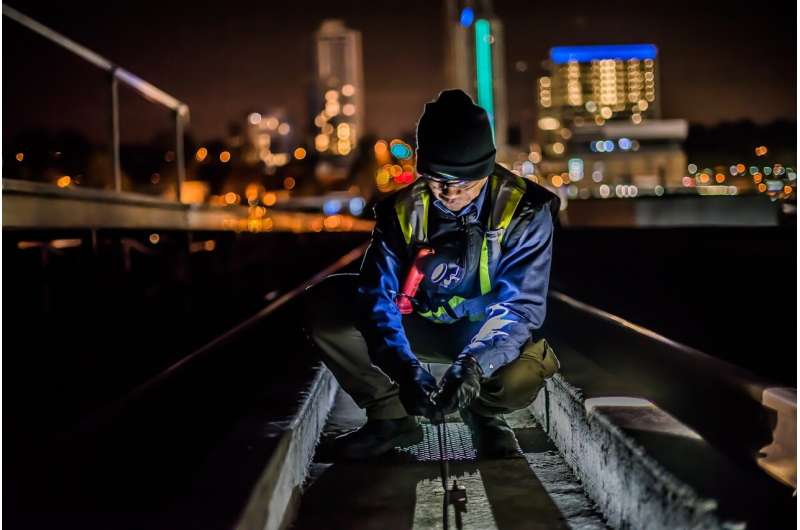
The use of circadian-informed lighting, where artificial lighting is synchronized to the natural biological rhythms or a person’s “body-clock,” significantly improves quality of sleep and work performance for night shift workers, a major new trial has found.
The Flinders University trial is among the first tightly controlled in-laboratory studies to have simultaneously evaluated circadian-lighting effects on markers of body-clock timing, work-shift cognitive performance, and sleep following an abrupt transition to night shift work.
The results of the trial have produced two papers published in SLEEP, finding that strategic exposure to light accelerated body-clock adjustment and improved alertness and performance, as well as sleep after a night shift.
“Circadian rhythms reflect our body’s internal clocks that control the activity and timing of bodily functions, including our sleep-wake cycle,” says Flinders University sleep researcher Dr. Hannah Scott, author of “Circadian-informed lighting improves vigilance, sleep, and subjective sleepiness during simulated night shift work,” published in SLEEP.
“Shift work causes circadian disruption, for which well-timed light exposure, designed to promote alertness and facilitate circadian adjustment, is one of the most potent methods to help retime the body clock.”
In Australia, about 15%–16% of Australian workers report being shift workers. For both men and women, rotating shifts with varying schedules each week are the most prevalent type of shift work.
The findings will be of particular interest for shift workers in enclosed environments such as submarines where lighting is typically dim.
“Given the complete lack of normal day-night lighting, shift work on submarines may be particularly challenging for the body clock to adjust to,” says Dr. Scott.
“We wanted to explore the unique challenges posed by night shifts, particularly the disruption to sleep-wake schedules, which can lead to impaired mental and physical performance, poorer sleep and health issues.
“We found that the use of circadian-informed lighting promoted better improved job performance and sleep for those working irregular hours,” says Dr. Scott.
A group of 19 adults participated in the study, which took place in FHMRI Sleep Health’s laboratory under tightly controlled conditions that simulated night work environments.
Participants were exposed to two different lighting scenarios for a period of eight days to compare how their body clock adjusted and how they performed in a series of tasks.
The circadian-informed lighting, consisted of blue-enriched and dim, blue-depleted conditions designed to help the body clock adjust to night work, while the traditional dim, blue-depleted lighting simulated the standard lighting conditions onboard submarines.
The research team then assessed key circadian measures including melatonin levels and core body temperature, along with other outcomes including cognitive performance and sleep.
Importantly, over four consecutive simulated night shifts, the circadian informed lighting shifted participants’ body-clocks around one hour faster per day compared to the standard lighting.
Alisha Guyett, lead author of “A circadian-informed lighting intervention accelerates circadian adjustment to a night work schedule in a submarine lighting environment,” also published in SLEEP, says that the findings are very promising for night shift employers and employees.
“The overarching benefits of circadian-informed lighting on sleep and alertness are very clear from this study. Our findings suggest that strategic lighting interventions can likely be used to enhance the performance, sleep, safety and well-being of night shift workers exposed to inadequate light during their work shift,” says Guyett.
“The circadian-informed lighting interventions significantly accelerated participants’ adjustment to night work, which could have important implications for improving the health and performance of those who regularly work night shifts.”
Notably, after circadian-informed lighting, participants achieved almost one hour more of sleep compared to the standard lighting condition as well as reporting lower levels of sleepiness during their shifts.
To test alertness, participants in both lighting conditions were subjected to the Psychomotor Vigilance Task (PVT) test, a behavioral attention measure. Those in circadian-informed lighting conditions made half as many (7.4 lapses) mistakes as those in standard lighting (15.6 lapses).
Senior Flinders Health and Medical Research Institute: Sleep Health researcher Professor Peter Catcheside says, “This study highlights the importance of the circadian system and circadian friendly lighting to help alleviate some of the significant challenges of shift work.
“It adds to what we already know about the use of these interventions to help optimize workspaces for enhanced performance, safety, and well-being in the modern workforce.
“These findings have important implications for submariner lighting conditions, but also mining and other workplace environments where lighting conditions may make it more difficult for shift workers to successfully adjust their body-clocks to the work schedule,” he adds.
More information:
Hannah Scott et al, Circadian-informed lighting improves vigilance, sleep, and subjective sleepiness during simulated night-shift work, SLEEP (2024). DOI: 10.1093/sleep/zsae173
Alisha Guyett et al, A circadian-informed lighting intervention accelerates circadian adjustment to a night work schedule in a submarine lighting environment, SLEEP (2024). DOI: 10.1093/sleep/zsae146
Citation:
Circadian lighting boosts sleep and performance for night shift workers (2024, September 26)
retrieved 28 September 2024
from https://medicalxpress.com/news/2024-09-circadian-boosts-night-shift-workers.html
This document is subject to copyright. Apart from any fair dealing for the purpose of private study or research, no
part may be reproduced without the written permission. The content is provided for information purposes only.


